Feature Interview with Bradford Becken
January, 2020
BRADFORD A. BECKEN, JR., age 72, graduated from Georgetown University’s College of Arts and Sciences with an AB, Economics and attended New York University’s Graduate School of Business. He spent his professional career as an investment banker, relocating to Los Angeles from New York City in 1985 in order to establish a west coast financial institution coverage presence for Goldman Sachs. After leaving Goldman Sachs, Becken was first CFO and then President of a small entertainment company based in Los Angeles until retiring in 2005. He grew up surfing and playing tennis in Southern California and did not start playing golf until his move back to Los Angeles in 1985. He describes himself as an average golfer although he continues to delight in playing 100+ rounds per year. He now spends most his time in North Carolina and is a proud member at Hope Valley CC, a 1926 Donald Ross design in Durham. He joined the Donald Ross Society in 2012, was elected to the board in 2016 and currently serves as its President. For more on the Donald Ross Society, please visit www.rosssociety.org .
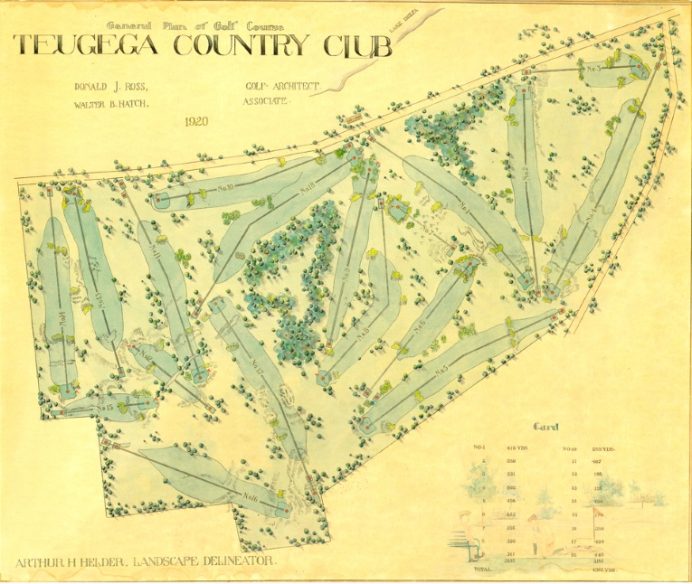
While Ross courses have been featured scores of times on television, much of his best work still flies under the radar, such as Teugega CC in New York.
1. When did you play your first Ross course? Which was it? Recollections from that day?
I played my first Ross course in either 1973 or 1974. At the time I was working for a Wall Street bank and was attending a meeting of the North Carolina Bankers Association in Pinehurst. Although I had grown up in Southern California playing tennis and surfing (no golf) my then boss needed a fourth for the round one day on Pinehurst #2. What I recall is wearing sneakers, playing with a rental set, not having a clue about what I was doing, and frequently picking up my ball so as to not cause a five or six hour round. That same boss subsequently drafted me for another round on #2 for the same reason and with the same results, but then mercifully never asked again. I did not play my next Ross course (Newport CC) until the mid-1980’s. By then I had been transferred to Los Angeles and actually started to take golf seriously. My father had joined Newport CC in Newport, RI and I enjoyed many rounds with him at Newport over the years at that wonderful course Ross had worked on.
2. Describe the path from that beginning to ultimately deciding to play all of Ross’s courses.
As I mentioned, living in Los Angeles I started to play golf more regularly and worked on my game. I ended up joining Los Angeles CC in the early 1990’s where I am still a member. Other than occasional rounds at Riviera CC, Bel-Air CC and a few other west coast courses, virtually all the golf I played was at LACC or Newport CC. After retiring my wife and I moved to Chapel Hill, NC and joined Chapel Hill CC. In 2010 when a good friend of mine from LACC came to visit, we played Chapel Hill CC and then the pro suggested we play Hope Valley CC, a nearby Ross course in Durham, NC. When I remarked how much I enjoyed it, the pro said, if that is the case, there are a lot more Ross courses in NC. To be candid, at the time, I knew very little about Donald Ross and his work.
That same year I quickly followed up with rounds at other nearby Ross courses such as Benvenue CC, Alamance CC, CC of Salisbury and Roaring Gap Club among others and by the end of 2011 I had played all of his work in NC as well as select courses in Virginia and South Carolina. By the end of 2012 I had played about 90 Ross courses and was travelling greater distances and for longer periods. As an example, my first Ross trip to Florida was that year as well as Ohio and I just kept going. Starting in 2013, I was traveling almost every other week starting in the spring and lasting through late fall, weather permitting, a pattern that continued until I finally finished in the fall of 2017.
3. What were some of the chief hurdles in completing the journey?
I was having so much fun traveling and playing different Ross courses that I didn’t really think about possibly playing them all until my count was around 220 or 230. The vast majority of Ross’ courses are private and access was not always easy. Being a member of two private clubs helped because of reciprocity but joining the Donald Ross Society in 2012 was also very important because I began to meet many members from Ross courses around the country and Canada who began to host me as I did them at Los Angeles CC. Seminole GC and Gulf Stream GC are probably the most difficult to access but I was fortunate enough to meet members of both a number of years ago. The biggest challenges were the absolute number of courses, time and distance. For example, while there is only one Ross course on the west coast (Peninsula Golf & CC in San Mateo, California) there are 10 in Canada and widely dispersed. The working total for the quest at the time was 357. More on that later.
4. By your count, how many Ross courses exist today?
What constitutes a Ross course is sometimes up for debate. Clearly an original design or remodel counts but there are also examples of courses where Ross worked collaboratively with another architect, sometimes informally. In some cases, Ross worked on only a limited number of holes at a course, and we know at times he functioned as an “Open Doctor” on behalf of the USGA although that term was not then in use. My current working total is 366, however this number is a bit of a moving target.
With the digitization of so much old media, we have learned of courses Ross worked on that were never previously on a Ross course list. For example, look at the remarkable amount of research that Sven Nilsen has accomplished. Conversely, we have learned of a few “Ross” courses that have turned out to be the work of another architect like Panama CC in Florida. The Donald Ross Society course list is the product of volunteers who work with the material that is available and update when a reason to change is identified.
Finally, and sadly, we are losing a Ross course every year or so to some alternative use reflecting the current difficult economic environment for golf.
5. What percentage of his courses do you think Ross paid at least one onsite visit prior to the course opening?
As I recall, Klein in “Discovering Donald Ross” estimates that Ross never saw perhaps a third of the courses he designed. I find this difficult to accept. We know that Ross was a constant traveler, often revisiting areas he had previously been. Even if one of his designs was built prior to Ross seeing the work, it is highly likely he would have reviewed the course at some later date and made suggestions or revisions if he felt them to be appropriate. Accordingly, I believe the percentage of his designs that he never visited to be less than 10% of the total but that is a rough estimate.
6. Tell us how you completed all 355+/- Ross courses on three (!) separate occasions.
In September, 2017 I played Rolling Rock Club in Pennsylvania which at the time was my 357th, and I thought final, Ross course. Within a month a fellow member of the Donald Ross Society sent me an article from a 1914 New Jersey newspaper talking about how Raritan Valley CC had brought in Ross to bunker a course originally laid out by HH Barker in 1912. The two had collaborated previously, for example, on Columbia CC in Chevy Chase, Maryland. I played Raritan Valley that October and again thought I was done.
Then Chris Buie published “The Life & Times of Donald Ross” and identified nine or ten more courses that were previously unknown to have been worked on by Ross. I played those in 2018.
Since then I have not learned of any additional such courses but will promptly play any that are. By the way, even if there is some doubt about a prospective course, I will play the course just to be sure. For example, Tippecanoe CC in Canfield, Ohio claims to be Ross design but I am not of aware of any historical records that confirm this. Accordingly, my Ross course count is slightly higher than others including the current list of the Donald Ross Society.
7. Did any region of courses stand out versus expectations?
Not really, there is a wide dispersion of high-quality Ross courses. The region that stands out the most, however, is New England. There are just so many of his courses there, much more so than any other part of the US or Canada.
8. By the mid-1920’s, Ross had offices in Illinois, Michigan, Pennsylvania, North Carolina and Rhode Island. Can you tell a difference if Hatch lead a project versus McGovern versus Maples?
I can’t or at least have not noticed such a difference. The golf architect Tyler Rae has noted that McGovern had a tendency to depart from Ross’ designs involving bunkers. If Ross, for example, called for one large bunker in a location, McGovern would sometimes divide it into two smaller bunkers much to Ross’ annoyance per Tyler.
9. Which five Ross designs would please him most based on how they are presented today? Why?
I think he would be pleased with much of his work but narrowing it down to five courses would include the following: Seminole, Aronimink, French Lick, Glens Falls CC, and Salem. Ross was a master at routing a course, taking advantage of existing terrain and land formations because he did not have the luxury of moving mountains of dirt like contemporary architects. (The bulldozer was not invented until sometime in the early 1930’s). Each of these five courses is exceptionally routed on outstanding terrain and their routings are largely intact.
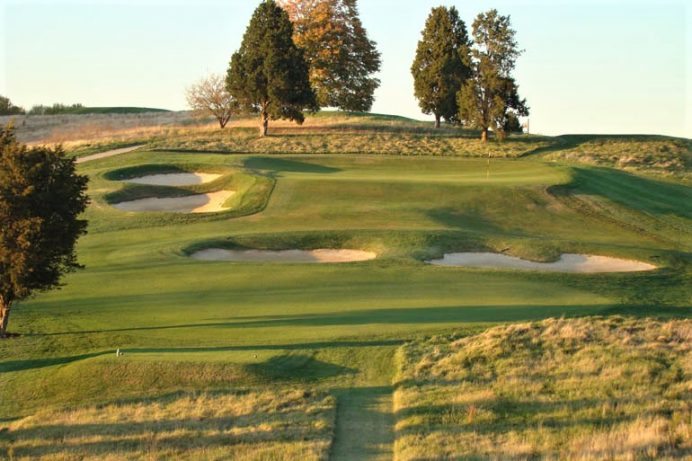
For bold playing features, head to the Ross course at French Lick in southern Indiana.
10. Which five courses would benefit the most from a restoration?
The significant benefits of a well planned and executed restoration are evident from the results at such courses as Cedar Rapids, Siwanoy and Roaring Gap Club, among others. Currently there are several clubs considering or close to undertaking a restoration including Belleair CC (West Course) in Florida, Chautauqua GC in western New York and Hope Valley CC in NC.
Belleair has a surprising amount of terrain for a Florida course and with two Ross courses, I think one of the best kept secrets in that state.
Chautauqua has experienced flattening of bunker and green complexes, as well as green shrinkage. Another issue is the trees that have been planted (and grown) over time that are affecting play. Chautauqua has already started to address these issues.
Hope Valley is a 1926 Donald Ross design with an excellent routing that is intact. Over the years other architects have worked on the course and unfortunately, eliminated many of the strong green and bunker features Ross had designed.
A fourth example is a course that is in the midst of a restoration with terrific results, Riverside CC in Rothesay, New Brunswick, Canada. Rothesay is a suburb of St. John and the course is characterized by dramatic terrain.
Finally, Mill Creek GC, in Boardman, Ohio is in the midst of a multi-year project to restore both 18 hole Ross courses using a combination of public and private funding and already with great impact.
11. What are five of the neatest design features (most memorable greens, best positioned bunkers, unique mounds etc.) that you encountered along your journey?
Green and bunker complexes are among Ross’ most memorable features generally. Brunswick CC stands out as having the most remarkable greens. Located in Brunswick, GA on a relatively flat piece of property, the club’s elevated greens have an exceptional amount of movement and are challenging to read. After a few holes, I remember thinking double or triple whatever amount of break I had visualized.
For bunkering it has to be Seminole GC. All through the course the bunkers there are so well located and if your ball gets anywhere near one of them, it’s going in.
Ross often designed “rough irregular mounds” which I think if they still exist on one of his courses, have been softened over time. But not at Teugega CC in Rome, NY, where the mounding looks wild and very much like what I believe Ross had in mind when designing this feature.
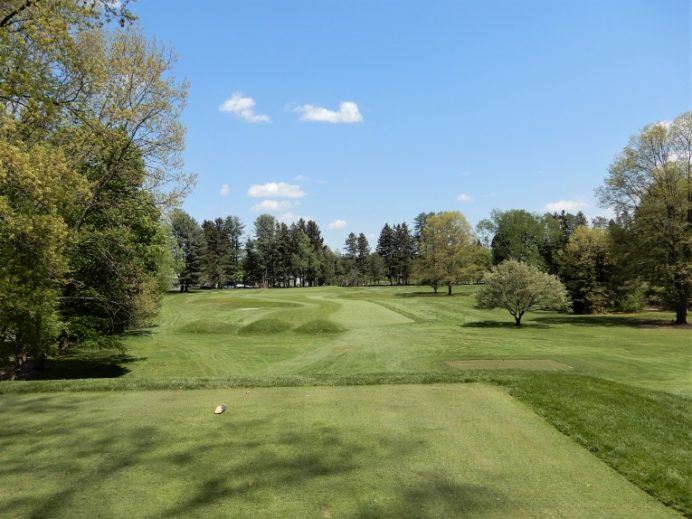
Ross enthusiasts know Ross spent a lot of time at Teugega and consider it one of his best.
Ross also frequently used mounding and undulations within his green complexes and some of the best examples of that are at Bald Peak Colony Club in New Hampshire.
A fifth feature is Ross’ use of hollows or valleys on his greens. In general, I believe this feature has also tended to be softened over time but is very much present on the 7th green at Allegheny CC.
Finally, Ross occasionally designed “Top Hat” greens and the best remaining example of that feature I have seen is at Barton Hills CC in Michigan. By “Top Hat”, I refer to a green that subtly mimics the brim and crown of a hat with the center of the green pushed up a bit like the crown of a hat.
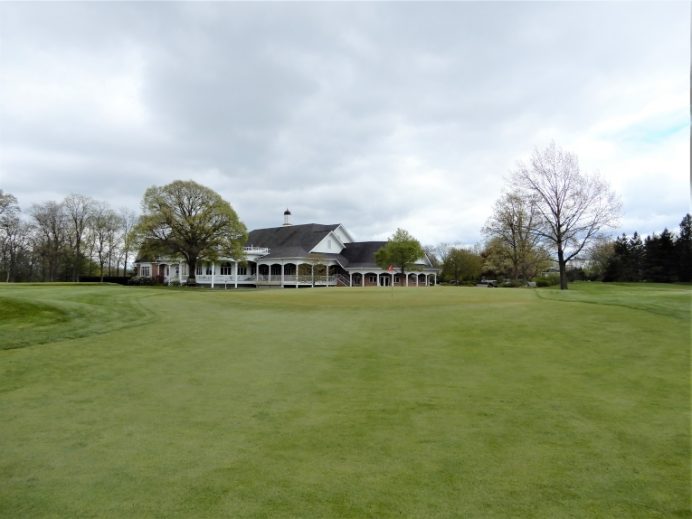
The 9th green at Barton Hills enjoys a distinctive, pushed-up central feature.
12. What are five underappreciated Ross courses that you recommend?
I would not describe Charles River CC as necessarily underappreciated but I still consider it to be the most underrated Ross course in New England. Have played there once a year for the past three years and it keeps rising in my estimation. Glens Falls CC and White Bear Yacht Club (giving due credit to William Watson and Tom Vardon as well) are two courses that I walked off after playing the first time thinking “Are you kidding me, how could every serious golfer not want to play both?” Simply outstanding. Idle Hour CC in Lexington, KY is another Ross course that I think is exceptional but doesn’t get the recognition it deserves. Finally, don’t forget Canada. Rosedale GC in Toronto, Ontario has a terrific Ross course and playing there is a thoroughly enjoyable experience.
13. What course of his no longer exists that you would most like to play?
The Roosevelt Memorial GC in Warm Springs, Georgia. An original 18 hole Ross design, only nine holes were built but Franklin D. Roosevelt hired Ross and was actively involved in the layout of the course. Although Roosevelt was at the time a Senator from New York and not yet President, he was a regular visitor to Warm Springs because of the therapeutic value of the water there having previously contracted polio. It is very unfortunate that a course with a history as significant as Roosevelt Warm Springs is closed.
14. Let’s talk about the bottom 5-10% of the 366 existing courses. Do common denominators exist? For instance, do they fail to resonate because of the work done on them after Ross’ death?
There are clearly Ross courses in existence that have grown tired and in need of restoration. In some cases, such courses have been altered by succeeding architects and suffered because of it. Tree planting programs haven’t helped particularly those that have allowed trees to overgrow the course. Maintenance practices have also hurt, it is not uncommon for greens to have shrunk 30-40% overtime because of mowing patterns. This is particularly evident because Ross frequently designed mounds and undulations that extended well but smoothly into his greens and now you can see a gap of several feet between the green surface and such mounding. There is also often the sense that the course has been flattened from the tees to the greens to the bunkers. If you look at all the bunkers Ross designed, those calling for a depth of 4’ or 4’6” accounted for perhaps as much as 96 or 97% of the total and yet you can find bunkers on Ross courses now closer to 4” deep.
The Donald Ross Society was formed in 1989 because members of Wampanoag CC were unhappy about the work that was done on their Ross course. Since then the Society, led by Michael Fay, has consulted, for free, on almost 150 Ross course restorations and has been instrumental in returning Ross’ design to such courses as well as providing momentum to the restoration trend that continues to this day.
15. Many Golden Age designs suffer from a club’s quest to host events, as it leads to narrowing of fairways, the planting of trees, and the reduction of green slopes. What three Ross courses should be applauded for remaining true to Ross’ design ethos while hosting events to this day?
This question is easy: Oakland Hills CC, Inverness Club and Oak Hill CC in Rochester, NY. All three are extremely important, not only for the excellence of their courses, but their impressive history and each’s longevity as a host for major events over the years. In addition, all three are in the midst of, or have completed returning Ross to their respective courses replacing the work of other architects done in the intervening years. Because of the stature of these clubs, I believe the steps they have taken will add measurably to the strength of the trend to restore Ross courses.
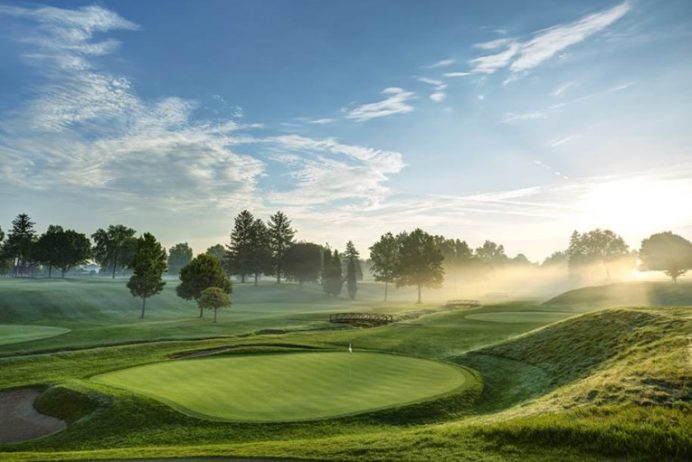
Inverness is back in peak form, thanks to recent work carried out by Andrew Green.
16. What are some myths behind his work that you would like to dispel?
Over the last several years I have spent a considerable amount of time closely studying Ross hole and green drawings grid line by grid line. Also, I have not only played every one of his courses that still exist, but extensively photographed each one and have closely compared today’s course to the drawings I have reviewed. The process is still ongoing but at this point have studied approximately 1,500 hole and green drawings (and routings if they exist for the corresponding course).
That said, one myth is that Ross “never put a bunker behind one of his greens.” I have heard this on multiple occasions and it is simply not true. In a matter of minutes, I could identity at least 50 and perhaps more than 100 Ross greens with a bunker behind the green in his hole drawing.
Another is that Ross did not like to use water hazards and again, not true. While it is clear from his writings that he wasn’t in favor of excessive use of water hazards, many of his designs include a creek running alongside a hole or bisecting a fairway or he even provide instructions to build a dam to create a pond. It is also clear from his designs that Ross was very attentive to drainage on his courses necessitating ditches or creeks etc. to help promote desired water flow.
In addition, I have heard the statement’ “Ross holes begin at the back of the tee and end at the back of the green.” Again, while this is generally true, it is clear from many of his field notes that he has called for fairway behind the green. At Mountain Brook CC in Alabama, one of his hole drawings even has “fairway” clearly designated behind a green.
When it comes to Ross greens, I have heard on a number of occasions that you can putt from any part of the green to any other part of the green. Also, a reasonably accurate description of most, but not all of his work. I have seen green drawings with spurs that would make the above statement questionable and in a number of cases almost “L” shaped greens. While it is technically possible in this instance for the player, depending upon the ball and pin location to putt anywhere, it might be necessary for the ball to travel through tall grass or even a bunker to get there.
This is probably a good point to also note that when describing Ross’ work, it is wise to avoid words like “always” or “never.” Unlike other architects he did not use templates but was extremely creative using the land in front of him. In addition, with 420 courses plus or minus to his credit, there is exceptional variety to his work. One of my favorite examples of this involves trees. It is evident from his writings that Ross thought trees had a limited purpose on a golf course except perhaps selected “specimen” trees or as a boundary or protective barrier between holes. At Augusta CC in Georgia there is a hole of the back nine with a bunker just short of and at the front left of the green. In the limited space between the bunker and the green Ross has clearly designated a “pine tree.” By the way, that tree (or its replacement) is still there.
17. Well said! What are some of your favorite raw pieces of property with which he was given to work?
Glens Falls CC and Seminole GC are two clear choices. I enjoy courses with significant terrain not only because of the variety and challenges they offer, but some of the visual experiences. Riverside CC in New Brunswick, Canada and Peninsula Golf & CC in San Mateo, CA are examples of this. From some of the tees at Peninsula, the player can see across the San Francisco Bay to Oakland, Alameda County and even Mt. Diablo in the distance.
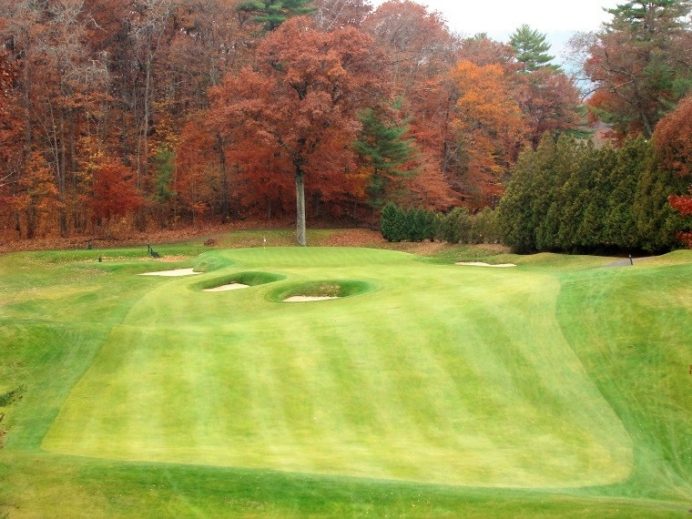
The better the land, the better the holes, especially in the hands of a master router like Ross. Above is the drivable short two shot 7th at Glens Falls.
18. In conclusion, what would you tell a custodian of a Ross course?
You have a precious work of art that should be preserved and/or restored. I also think in this challenging economic environment for many golf courses, being a Ross course is a real asset and competitive advantage. It is unusual to look at the website for a Ross club and not have the fact that Donald Ross designed the course highlighted. Also, please don’t change the routing of the course because 1% or fewer of your members can hit the ball a mile.








